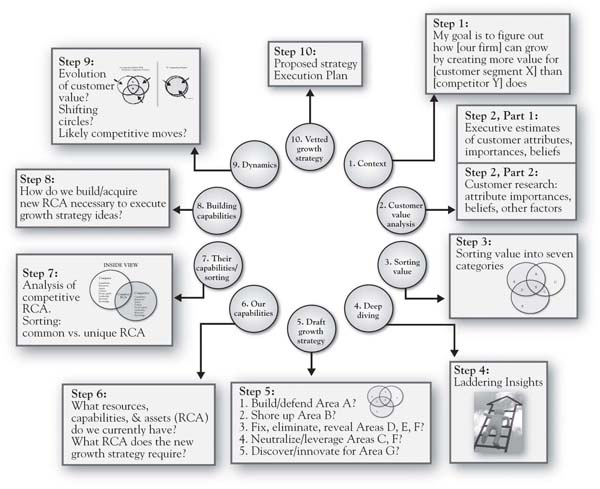This is “Chapter Summary”, section 9.9 from the book Competitive Strategies for Growth (v. 1.0). For details on it (including licensing), click here.
For more information on the source of this book, or why it is available for free, please see the project's home page. You can browse or download additional books there. To download a .zip file containing this book to use offline, simply click here.
9.9 Chapter Summary
Beating the competitor, creating value for customers, and building capabilities may be seen as goals or principles that are often at odds with one another. So most firms tend to focus on one or two of those goals. The search for growth is further complicated by the fact that knowledge of customer needs can get quickly out of date even though we feel confident in our existing knowledge. The imperative here is first to narrow the focus to the three core principles, to focus on understanding customer value as primary, but then to also think of those principles as an integrated whole. The 3-Circle model provides an integrated view of these three principles and allows a team to quickly understand the current nature of competitive advantage in their markets. The 10-step process for 3-Circle growth strategy development is summarized in Figure 9.7 "The 10-Step Process with Summary Points" with an additional brief description of each step.
One of us recently gave a talk to Notre Dame alumni in San Francisco. At the reception following the seminar, a conversation with new, incoming MBA students in attendance was joined by Ryan Else, an entrepreneur who had recently graduated from the Notre Dame executive MBA (EMBA) program. Ryan told the tale of his most recent company, Corte, LLC, a manufacturer and marketer of environmentally friendly chemical products. The company had developed a product called Corte-Clean, which is a nontoxic, chlorine-free agent for cleaning composite decking material commonly used for backyard decks. Ryan had developed the competitive positioning strategy for Corte-Clean in a 3-Circle growth strategy project in his EMBA marketing core course. With composite decking increasing from 2% to 20% of all decks, yet with the cleaning-solution category dominated by existing players, the company needed a solid positioning strategy to leverage that growth. The 3-Circle analysis revealed that Corte-Clean could be most powerfully positioned against competitors PSC, Behr and Olympic, with a focus on the absence of harsh chemicals (eco-friendliness) as the core of Area A, supported by ease of use and shelf life. It turns out these values all mattered a great deal to customers. Taking an even deeper look at customer buying behavior, though, Ryan’s analysis revealed that the company’s Internet site could become an important sales tool after discovering the importance that customers place on subscription sales plan and worry-free regular ordering called AutoShip. These were key insights on which Corte LLC developed strategy for penetrating key retail partners. The company went from about 100 stores in 2007 to over 3,800 stores in 2010. Sales of Corte-Clean more than doubled between 2007 and 2009, and sales in the first 4 months of 2010 have exceeded all of 2009 by 44%. The product is now distributed domestically through Lowe’s, ACE Hardware, True Value, and 84 Lumber, and has stretched, through its website and through international distribution, to Germany, France, Spain, England, Australia, the UAE, and Scandinavia.
Figure 9.7 The 10-Step Process with Summary Points

While Ryan generously attributes the success of his new venture to his 3-Circle project, in fact, the 3-Circle model cannot take credit. That success was a function of the Corte team’s determined market insight, development of an innovative product that delivered on important customer values, a solid website, and dogged persistence in getting distribution. However, the case study does illustrate effective application of the principles that lay a foundation for effective competitive strategy with which we began this book:
- Create important value for customers
- Be different from (better than) the competition
- Build and leverage your capabilities with an eye toward the desired customer value
In sum, Ryan’s company has now crafted a unique competitive position in its market, and that position is built upon the firm foundation of a truly, substantively different product that customers (and, subsequently, retailers) highly value. The primary credit that the 3-Circle model can claim is in helping to keep all eyes focused on the value sought by customers, the desired competitive position, and building the capabilities that allow the team to deliver on that position honestly. As with many of the case study successes we have explored in which the 3-Circle model has been applied, in the end, Ryan’s product matters more to customers than do competitive products. That is something worth growing.




